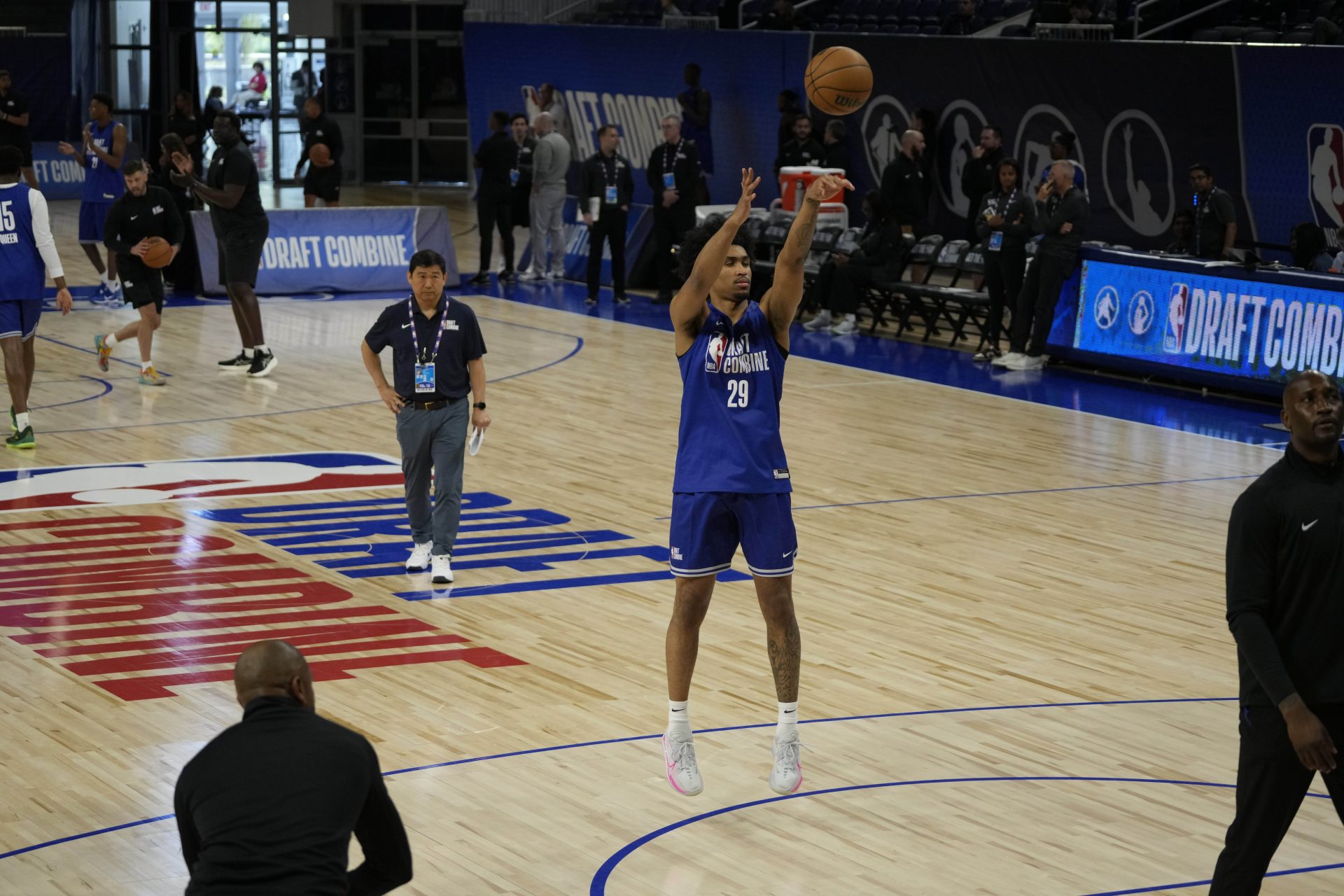The NBA Draft Combine serves as basketball’s most revealing job interview, where dreams soar or crash based on measurements, athletic testing and scrimmage performances. The 2025 edition in Chicago proved especially consequential, with several prospects dramatically altering their draft trajectories through standout showings or disappointing displays.
As front offices recalibrate their draft boards, let’s examine which prospects capitalized on the spotlight and which ones left Chicago with more questions than answers.
Big Winners in NBA Draft Combine
Maxime Raynaud
Social media buzzed with highlight clips of Stanford’s Maxime Raynaud dominating combine scrimmages. The French big man measured impressively at over 7-foot barefoot, dimensions similar to Toronto Raptors center Jakob Poeltl.
Raynaud showcased his versatile skillset with 20 points, 9 rebounds and 3 assists in just 25 minutes of action. He silenced critics by hitting three-pointers, displaying advanced ball-handling and playing with increased defensive intensity that addressed pre-combine concerns.
Cedric Coward
Cedric Coward entered the combine as a fringe prospect but left as one of its breakout stars. His measurements of 6-foot-5 with an extraordinary 7-foot-2 wingspan and an 8-foot-10 standing reach has stunned scouts.
Beyond his physical tools, Coward dazzled in shooting drills. He converted 23 out of 30 shots off the dribble, 18 out of 25 spot-up attempts, 17 out of 25 in the three-point star drill, 14 out of 23 corner threes and 9 out of 10 free throws.
Hansen Yang: China’s Mystery Man Shines
Chinese prospect Hansen Yang used the combine to introduce himself to NBA decision-makers. Measuring 7’1″ and 252.6 pounds, Yang backed up his impressive CBA resume where he won Player of the Year honors in 2024.
Yang delivered in scrimmages scoring 12 points on 5-of-7 shooting in his first game and following with 11 points, six rebounds and six assists in his second outing. His playmaking abilities were particularly impressive with executives expressing interest in seeing him compete in NCAA basketball.
Tahaad Pettiford: Speed and Skill on Display
Auburn guard Tahaad Pettiford compensated for his modest 6-foot frame with electrifying performances. He led all scorers with 23 points on 4-of-8 shooting from beyond the arc while adding 8 assists against just 1 turnover and snagging 2 steals in 26 minutes.
Pettiford showcased exceptional athleticism with a 42-inch vertical leap, the second highest mark at the combine. His excellent pace control, finishing and pull-up three-point shooting demonstrated NBA ready skills that outweighed size concerns.
Other prospects
North Carolina’s Drake Powell tested as the combine’s premier athlete with the highest vertical leaps and impressive sprint times.
Texas guard Trey Johnson solidified his top-six projection by converting 68% of his shooting drill attempts.
Alabama’s Mark Sears dominated shooting drills, finishing first in three categories despite ranking just 78th in pre-combine rankings.
UAB’s Yaxel Lendeborg moved into first-round consideration with strong scrimmage play.
Big Losers in NBA Draft Combine
Ace Bailey: Height Discrepancy and Athletic Concerns
Rutgers’ Ace Bailey entered the combine as a projected top-4 pick but faced significant scrutiny after his official measurements revealed a stark discrepancy. Listed at 6’10” during the college season, Bailey measured just 6’7″, a 2.5-inch difference that shocked scouts.
Bailey’s athletic testing compounded concerns, as his 34-inch max vertical leap ranked as mediocre compared to expectations. While his scoring instincts remain valued, teams now question whether his lack of size and elite explosiveness will limit his ceiling against NBA caliber defenders.
Vladislav Goldin: Struggles with Pace and Impact
Michigan’s Vladislav Goldin, a 7’0″ center failed to leverage his physical tools during scrimmages. In his first game, he shot 1-of-6 from the field and contributed just 3 points and 2 rebounds in 14 minutes.
Goldin’s lack of vertical explosiveness and slow footspeed were glaring weaknesses. He rarely finished above the rim as a lob threat and appeared overmatched in transition, raising doubts about his fit in modern NBA systems that prioritize mobility from big men.
Derik Queen: Undersized and Underwhelming
Maryland’s Derik Queen faced harsh reality checks regarding his physical tools. Measuring 6’9″ and 247.8 pounds, Queen’s frame and wingspan fell short of NBA center standards, while his 28-inch vertical leap ranked among the worst for big men in combine history.
Queen’s limited defensive switchability and absence of three-point range further damaged his stock. Without elite physical tools, his path to NBA success now depends on developing as a high-usage offensive hub.
Max Shulga: Invisible in Scrimmages
VCU’s Max Shulga entered the combine hoping to prove himself against higher competition but instead faded into obscurity. Measuring 6’4″ with a 6’5″ wingspan, Shulga posted unremarkable athletic scores and failed to make any notable impact in scrimmage play.
Scouts noted he fell off the radar unless specifically assigned to watch, a damning assessment that likely relegates him to undrafted status. Shulga’s passive playstyle and lack of standout traits demonstrated the challenges mid major standouts face when competing against higher level prospects.
KEEP READING: Youngest at the NBA Combine, Michael Ruzic Shows Glimpses of Potential Despite Tough Matchups
Other fallers included Auburn’s Johni Broome whose 28.5-inch vertical leap ranked among the combine’s worst, Houston guard Milos Uzan who shot just 3-for-12 across two scrimmages, and Croatian center Michael Ruzic who appeared physically overmatched at just 221 pounds. These performances highlighted the unforgiving nature of the combine, where a single poor showing can erase months of collegiate production.
As the May 28 withdrawal deadline approaches, these combine performances will shape career defining decisions. For some like Raynaud and Coward, Chicago represented a launching pad to first round consideration. For others like Bailey and Queen, the combine exposed limitations that could cost in draft positioning and future earnings.
College Sports Network has you covered with the latest news, analysis, insights, and trending stories in football, men’s basketball, women’s basketball, and baseball!


